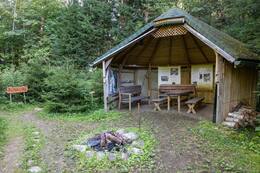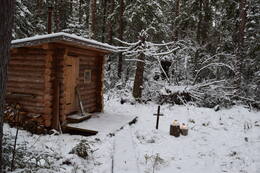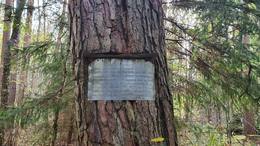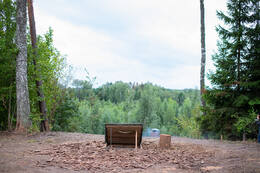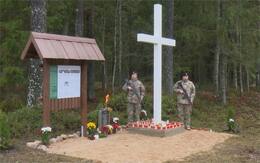Partizanų/partizanų bunkeris
III Nacionaliniai partizanai, II Antrasis pasaulinis karas, IV Sovietų okupacija
Požeminė arba pusiau požeminė bazė miške, pelkėje ar kitoje sunkiai pasiekiamoje vietoje, dažniausiai atokiau nuo apgyvendintų vietovių, kurioje gali prieglobstį rasti ginkluoto pasipriešinimo judėjimo nariai ir jų rėmėjai.
Norint suprasti šį istorijos puslapį, buvo restauruoti keli nacionalinių partizanų bunkeriai, kuriuos gali aplankyti visi. Bunkerių yra Ilėje, Amatoje ir tarp Vietalvos bei Jaunkalsnavos.
Ylės partizanų bunkeris yra vienas didžiausių bunkerių Baltijos šalyse, kurį 1948 m. pastatė jungtinės Latvijos ir Lietuvos grupės partizanai. Bunkeris buvo pastatytas kaip laikinas štabas 1948/1949 m. žiemai Ylės miškuose praleisti. Po kelių mėnesių bunkerį atrado ir užpuolė Valstybės saugumo komitetas. Po penkias valandas trukusių mūšių žuvo 15 partizanų, o devyni buvo paimti į nelaisvę. AB „Latvijas valsts meži“ paramos dėka bunkeris buvo restauruotas, o jo įranga išsaugota tokia, kokia buvo 1948 m. žiemą. Ylės nacionalinių partizanų bunkeris visuomenei atviras bet kuriuo paros metu.
Daugiau informacijos šaltinių
Latvijos nacionalinių partizanų kovos – Nacionalinė enciklopedija (enciklopedija.lv)
Susijusi laiko juosta
Susijusios vietos
Nacionalinių partizanų bunkeris – Miško broliai
Miško brolių bunkeris yra prie Rygos–Pskovo (A2) greitkelio, 76 kilometrus nuo Rygos ir 11 kilometrų nuo Cėsių. Latvijos nacionaliniai partizanai arba miško broliai buvo nedidelės, ginkluotos vietos gyventojų grupuotės, kurios nuo 1944 iki 1956 metų Latvijos teritorijoje kovojo savarankiškai prieš SSRS okupacinį režimą. Miškuose buvo priversti slėptis žmonės, kurie negalėjo arba nenorėjo gyventi Sovietų Sąjungoje. Iš viso Latvijoje veikė apie 20 193 miško broliai. Bunkeris buvo suformuotas remiantis buvusių miško brolių pasakojimais ir prisiminimais apie gyvenimą miškuose, slapstymąsi ir kovą už nepriklausomą Latvijos valstybę po 1945 metų. Bunkeryje eksponuojami ginkluotė ir namų apyvokos daiktai. Eksponuojami partizanų asmeniniai daiktai, ginklai ir nuotraukos. Gido pasakojimą papildo vaizdo įrašas iš interviu su miško broliais. Prie bunkerio yra vieta piknikui. Galima iš anksto užsisakyti ant laužo paruoštos sriubos arba mėgautis vakaru po atviru dangumi žiūrimu kino teatru prie laužo.
Atminimo lenta Veclaicenės nacionaliniams partizanams bunkerio vietoje
Įsikūręs Veclaicenės valsčiuje, Alūksnės rajone.
Atidaryta 2019 m. spalio 4 d. Akmenkalis Ainārs Zelčs.
1953 m. kovo 13 d. Veclaicenės miškuose, netoli „Korulių“ namų, čekistai aptiko kruopščiai užmaskuotą bunkerį ir suėmė Bernhardą Ābelkoką ir Elmārą Tortūzą.
Bunkeryje buvo rasti ginklai: 2 vokiški šautuvai ir 95 šoviniai, 2 „Parabellum“ pistoletai ir 152 šoviniai.
1949 m. lapkričio 11 d. Čekos agentai sušaudė K. Dokti-Dokteniekus, o jo grupuotė iširo. Po išpuolio B. Ābelkoksas ir E. Tortūzis kurį laiką slapstėsi bunkeryje netoli „Maskalių“ namų, tačiau nuo 1951 m. pavasario, padedami Ilonos Ābolkalnos, įsikūrė bunkerį „Koruliuose“, kur gyveno iki suėmimo.
Nacionalinės partizanų grupės „Jumba“ bunkerio atminimo vieta
Įsikūręs Ziemerso parapijoje, Valstybinio miško 66-ajame kvartale.
Memorialas buvo atidengtas 2020 m. liepos 10 d.
Antrajame Latvijos nacionalinio partizanų judėjimo etape, 1948 m. viduryje, nuo J. Bitāno-Liepačo būrio Mālupē-Bėjos valsčių teritorijoje atsiskyrė 4 asmenų grupė - Vikas Pētersis, Steberas Rolandas, Bukanas Ilgmārs ir Kangsepa Elvīra, kurie pradėjo savarankišką veiklą Ziemeros-Jaunlaicenės-Veclaicenės valsčiuose. Partizanų štabas buvo netoli Estijos sienos, netoli Rygos-Pskovo plento, ant kalvos, gerai įrengtame bunkeryje.
1950 m. kovo 2 d., čekistams aptikus bunkerį, partizanai pasislėpė iš riedulių pastatytame tvarte „Napke“ name Estijos pusėje. Po ilgų ir įnirtingų susišaudymų 1950 m. kovo 3 d. čekistams pavyko tvartą padegti. Ilgmārs Bukāns, Rolands Stebers ir Elvīra Kangsepa sudegė kartu su naujagime dukra. Pēteris Viks iššoko pro tvarto langą ir pasislėpė namo palėpėje, kur buvo rastas ir sušaudytas. Ūkis buvo sudegintas. Visų žuvusių partizanų kūnai buvo išvežti į Alūksnę. Kovotojų žūties vietoje 1990-ųjų pradžioje buvo pastatytas atminimo ženklas. Elvyros Kangsepos dukra, gimusi degančiame tvarte, buvo vardu Liesma.
Atminimo vieta „Bitanos bunkeriai“
Įsikūręs Mālupės valsčiuje, Alūksnės sav.
Atminimo akmuo atidengtas 2017 m. spalio 13 d. Akmenkalis Ainārs Zelčs.
1945 m. rugpjūčio 24 d. Latgaloje, Dubnos miškuose, buvo įkurta Latvijos nacionalinė partizanų asociacija (LNPA), kurios tikslas buvo atkurti 1918 m. Latvijos Respubliką. Siekiant geriau koordinuoti partizanų grupių veiklą, buvo įsteigti regioniniai štabai. Bejos, Mālupės ir Mārkalnės valsčiuose veikusios nacionalinės partizanų grupės susijungė į „Priedolainės“ sektorių. Regioniniam štabui vadovavo Janis Liepacis. Kiekviename regioniniame štabe buvo įsteigti propagandos skyriai. Vienas iš jų, vadovaujamas Janio Bitāna, buvo įkurtas Mālupės valsčiaus miškų masyve. Čia, bunkeryje, nuo 1946 iki 1948 m. buvo spausdinami penki Latvijos nacionalinės partizanų asociacijos spaudos leidiniai: „Mazais Latvis“, „Liesma“, „Auseklis“, „Māras Zeme“ ir „Tautas Sargs“. Alūksnės gimnazijos jaunimo pasipriešinimo judėjimas „Dzimtenes Sili“ dalyvavo informacijos rengime ir skleidime.
Atminimo akmuo Ilzenėje, prie „Sarvių“ ir „Melių“ namų.
Įsikūręs Ilzenės valsčiuje, Alūksnės savivaldybėje.
Atminimo akmuo atidengtas 2018 m. rugsėjo 28 d. Akmenkalis Ainārs Zelčs.
Šių Ilzenės valsčiaus namų gyventojai nuo 1944 m. rudens rėmė Voldemaro Andersono („Vec“) vadovaujamus nacionalinius partizanus, kurių bunkeris buvo netoliese, miško tankmėje. 1945 m. lapkričio 23 d. bunkerį apsupo NKVD kareiviai. Mūšyje žuvo devyni kovotojai. Po mūšio buvo rasti 2 kulkosvaidžiai, 14 automatinių šautuvų, 11 šautuvų, 10 pistoletų, 3500 šovinių, 45 granatos, 4 žiūronai. Voldemaro Andersono grupės sunaikinimas buvo suplanuotas Čekos agentūros byloje „Grandinė“ („Цепь“).
Grupę sudarė Voldemaras Pāvelsas Andersons („Vecais“), Gastonsas Dzelzkalējs, Voldemaras Tonnis, Centis Eizāns, Osvalds Kalējs, Jānis Koemets, Stāvais („Polis“), Voldemārs Rappa, Eduards Rappa, Elmārs Rappa (liko gyvas).
Galima Otomaro Oškalno bunkerio vieta
Atoki ir sunkiai prieinama vieta yra didelis miškų masyvas, esantis apie 200 m į vakarus nuo Žegos upės ir apie 0,5 km į pietvakarius nuo Žegos užliejamos lygumos. Į minėtą vietą rekomenduojama nuvykti pėsčiomis arba dviračiu, naudojantis LIDAR žemėlapiais ir geografinėmis koordinatėmis. Minėtoje vietoje yra maždaug kilometro ilgio (V – R kryptimi) ir pusės kilometro pločio (Š – P kryptimi) natūralus kopų kalnagūbris, apaugęs spygliuočių mišku. Kopų masyvo šiaurinio ir rytinio šlaitų viršutinėse dalyse yra gerai išsilaikę apkasai, spėjama, iš Antrojo pasaulinio karo laikų. Harijs Jaunzems (buvęs Kegumo HE inžinierius) mano, kad šioje vietovėje (konkreti vieta nežinoma) buvo Otomāro Oškalnso suformuoto Raudonosios armijos partizanų būrio bunkeris.
Dailonio Breikšo vadovaujamų nacionalinių partizanų atminimo vieta „Daiņkalni“
Įsikūręs „Daiņkalni“ gyvenvietėje, Raunos valsčiuje, Raunos rajone (šalia „Mežvijų“ namų Smiltenės rajone, Brančių valsčiuje).
Patekti į memorialinę vietą galima tik kartą per metus – balandžio 16 d.! Kelias veda per privačią valdą.
Atminimo vieta įkurta buvusių „Daiņkalni“ ir „Graškalni“ namų vietoje Raunos valsčiuje, kurių bunkeriuose nuo 1950 iki 1952 m. slapstėsi Dailonio Breikšo (slapyvardis Edgaras, 1911–1952) vadovaujama nacionalinių partizanų grupė. D. Breikšo nacionalinių partizanų grupė buvo įkurta 1948 m. ir iki 1950 m. jie gyveno Gatartos valsčiaus „Jaunvieslavene“ pas savo dvarininką Kārlį Lačį. 1950 m. D. Breikšo partizanų grupę išdavė jo paties brolis Laimonis, todėl jie buvo priversti persikelti. Vasaromis jie gyveno miškuose, o žiemas leisdavo Raunos valsčiaus „Daiņkalni“ pas miškininką Artūrą Pērkoną (1907–1952) ir bunkeriuose, pastatytuose po namais netoliese esančiuose „Graškalni“.
Nuo 2002 m. memorialinė vieta „Daiņkalnuose“ buvo palaipsniui tvarkoma. Kiekvienais metais balandžio 16 d. rengiami atminimo renginiai Dailonio Breikšo vadovaujamiems nacionaliniams partizanams atminti. 2003 ir 2004 m. balandžio mėn. prie „Daiņkalnų“ ir „Graškalnų“ namų buvo atidengti atminimo kryžiai ir lentos. 2016 m. rudenį – 2017 m. pavasarį, padedant vietos Raunės gyventojams, memorialinė vieta buvo rekonstruota pagal architekto Z. Butano eskizus, o buvusio bunkerio vieta buvo iškasta ir sutvirtinta.
Nacionalinių partizanų atminimo vieta Sērmūkšyje
Sērmūkšuose yra vienas iš daugiau nei šimto partizanų kovų memorialų Latvijoje. Latvijoje yra daugiau nei šeši šimtai partizanų kovų vietų. Remiantis istoriniais įrodymais pastatytas Latvijos nacionalinių partizanų žeminė, kurioje lankytojai gali praleisti naktį beveik autentiškomis sąlygomis su medinėmis lovomis, apšvietimu žibalinėmis lempomis ir šildymo prietaisu, panašiu į tuos, kuriuos naudojo partizanai. Apsilankymą būtina užsisakyti iš anksto. Lemtinga akimirka Sērmūkšų nacionalinių partizanų grupei atėjo 1946 m. lapkričio 29 d., kai žuvo keturi grupės kovotojai: Janis Zīrāks, Reinholds Pētersons, Janis Pīlands ir Anna Zariņa. Alfrēdsas Suipe išgyveno, atlaikė tremtį, grįžo į Latviją ir sulaukė laisvos valstybės atkūrimo. Jis inicijavo idėją Sērmūkšuose įsteigti memorialinę vietą savo žuvusiems bendražygiams.
Miško brolių sodyba Verumoje
„Forest Brother“ ūkis yra netoli Latvijos sienos, Vastse-Roosos kaime.
Bunkerio turizmo objektas buvo atidarytas 1999 m., siūlydamas lankytojams galimybę patirti miško brolių gyvenimo būdą kaip Estijos istorijos skyrių. Programa apima miško brolių paiešką slėptuvėje, bunkeryje apsilankymą, susipažinimą su tikrais gyvenimo įvykiais, miško brolių dainų dainavimą su šeimininku ir miško brolių valgio ar puotos ragavimą. Pagrindinis traukos objektas yra bunkeris, išklotas siaurais pušiniais rąstais ir įleistas į kalvos šlaitą. Bunkeryje yra dviaukštės lovos ir nedidelis staliukas. Šio tipo bunkerius XX a. 5-ojo dešimtmečio pabaigoje ir 6-ojo dešimtmečio pradžioje naudojo šimtai drąsių pasipriešinimo vyrų, prislėgtų būtinybės slapstytis nuo valdžios.
Paminklas miško broliams Puutlyje
Puutlipalo paminklas ir bunkerio vieta yra Mutsu kaime, Veru apskrityje. 1953 m. kovo 28 d. Puutlipalo mieste įvyko paskutinis didelis susirėmimas tarp „Miško brolių“ ir sovietų saugumo pajėgų. Žuvo visi aštuoni miške besislapstę žmonės – trys moterys ir penki vyrai. Bunkeris buvo sunaikintas, o kūnai išgabenti iš miško ir palaidoti nežinomoje vietoje.
Šis paminklas, skirtas žuvusiems miško broliams, buvo atidengtas 1989 m. gegužės 20 d. netoli buvusios bunkerio vietos. Tai buvo pirmasis paminklas Estijos pasipriešinimo kovotojams, pastatytas tuo metu, kai šalis dar buvo sovietų okupuota, o miško broliai vis dar oficialiai buvo vadinami banditais. Priešingai nei daugelis vėliau pastatytų panašių paminklų, kuriuos komunistai susprogdino, Puutlipalo paminklas liko nepaliestas dėl paslėptos vietos. Originali akmeninė lentelė yra vienintelis pakeistas elementas, nes ant jos (dėl daugelio metų valstybės paslapties) per klaidą buvo užrašytas kitame mūšyje žuvusio pasipriešinimo kovotojo vardas.
2013 m. sausį Vidaus saugumo tarnybos atlikto tyrimo metu atlikti DNR tyrimai atskleidė aštuonių Puutlipalo mieste nužudytų miško brolių tapatybes. Tais metais, Pasipriešinimo kovų dieną, jie buvo perlaidoti Vastselinos kapinėse.
Miško brolių memorialas Saikoje
Saikos bunkerio mūšis įvyko 1951 m. kovo 7 d. Keturias valandas trukęs susirėmimas buvo vienas iš nedaugelio „Miško brolių“ istorijoje, kai sovietų pajėgos patyrė nuostolius, prilygstančius pačių „Miško brolių“ nuostoliams. Iš aštuonių bunkeryje buvusių „Miško brolių“ tik dviem pavyko pabėgti. Jie žuvo po dvejų metų Puutlipalo mūšyje.
Memorialas buvo atidengtas 2007 m. per Jonines, šalia pagrindinio kelio. Aistringi žygeiviai bunkerio vietą taip pat ras, jei 700 metrų eis miško takais į pietryčius nuo memorialo. Mūšio vietos koordinatės: 57°39'22.2”, 27°18'49.9". Pastaba: atkreipkite dėmesį, kad Vastselinos kapinėse esančioje Saikos memorialinėje eglėje iškaltos koordinatės yra netikslios.
Vastselinos miško brolių memorialas
Šio „Miško brolių“ memorialo planai buvo pradėti kurti 2013 m. pradžioje, kai Vidaus saugumo tarnyba identifikavo masinėje kapavietėje Reedopalo mieste netoli Veru rastus kūnus. Bendradarbiaujant Vastseliinos savivaldybei, Estijos gynybos lygos Veru regioniniam padaliniui ir Gynybos ministerijai, buvo nuspręsta dėl vietos kapinėse ir atlikti reikalingi pasiruošimai. Trylikos „miško brolių“ perlaidojimas įvyko 2013 m. rugsėjo 21 d. Po metų čia buvo atidengtos Mati Karmino sukurtos memorialinės skulptūros, vaizduojančios mažas, iš akmens išskaptuotas egles. 2015 m. lapkričio 1 d. čia buvo perlaidoti dar keturi „miško broliai“, kurių kūnai buvo rasti slaptoje masinėje kapavietėje Reedopalo mieste, ir atidengta daugiau memorialinių eglių, skirtų atminti trijuose skirtinguose mūšiuose žuvusiuosius. Jų tikrieji kapai iki šiol nežinomi.
Pragaro dugno (Põrgupõhja) bunkeris
Põrgupõhja bunkeris yra miške netoli Tiduvere kaimo, Raplos apskrityje.
Iki 1945 m. antisovietinis pasipriešinimas daugelyje okupuotų žemių, įskaitant Estiją, virto organizuotu pasipriešinimo judėjimu. Buvo bandoma suvienyti kovotojų grupes ir sukurti tinklą. Šis 1947 m. pastatytas bunkeris buvo svarbi miško brolių tvirtovė.
Visiškai rekonstruotas Põrgupõhja bunkeris buvo atidarytas 2015 m., jame pristatomas kasdienis miško brolių gyvenimas. Visi norintys gali praleisti naktį bunkeryje ir įsivaizduoti, ką reiškė gyventi slapstantis.
Greta yra originali bunkerio, kurį 1947 m. gruodžio 31 d. sunaikino NKVD, vieta, jį supanti purvo siena ir memorialas žuvusiems miško broliams.
Miško brolių muziejaus kambarys Nursi kaimo centre (su memorialu ir netoliese esančio bunkerio kopija)
Įėjimas nemokamas, o muziejaus kambarys dirba bibliotekos darbo valandomis. Bunkeris yra neužimtoje Gynybos pajėgų poligono Nursipalu dalyje. Pratybų metu netoliese girdisi šūviai. Paskutinė kelio atkarpa, vedanti ten, vairuotojams gali būti sudėtingesnė, tačiau didžiąją laiko dalį ji pravažiuojama. Žemė aplink bunkerį gali būti šlapia.
Liukos (Nursi) bunkerio mūšis įvyko 1945 m. gruodžio 28 d. Susirėmime žuvo devyni miško broliai, o antžeminis bunkeris sudegė. Trims vyrams pavyko pabėgti. Mūšio vieta buvo atrasta po daugelį metų trukusių paieškų 2008 m. Po metų prie Veru-Valgos kelio buvo atidengtas mūšio memorialas. Pirmieji kasinėjimai bunkerio vietoje buvo atlikti 2010 m., o tais pačiais metais buvusioje Nursi mokykloje buvo atidarytas mūšiui skirtas muziejaus kambarys. (Miško brolių naudota rašomoji mašinėlė šiuo metu eksponuojama Veru apskrities muziejuje.)
Ehmjos miško brolių memorialas
Po Antrojo pasaulinio karo 20 vyrų iš Ehmjos susirinko į Miško brolių būrį. 1945 m. pabaigoje buvo pastatytas rąstinis bunkeris. Bunkeris buvo pastatytas ant žemės ir aptvertas pylimu. Negilus griovys aplink bunkerį avarinėmis situacijomis pakeitė apkasą. Už aštuonių metrų nuo bunkerio vietos stovi 80 cm skersmens ir 2,3 metro gylio šulinys. 1946 m. sausio 20 d. penki grupės nariai buvo sugauti per reidą į vieną iš Ehmjos ūkių. Dėl kažkokių priežasčių bunkeryje besislepiantys vyrai apie tai negirdėjo. Slapta bunkerio vieta buvo žinoma kitą dieną ir netrukus jį apsupo didžiulės pajėgos. Miško broliai atsisakė pasiduoti ir visi žuvo per valandą trukusias susišaudymus. Jų kūnai buvo nuvežti į Hapsalu ir palaidoti nežinomame kape.
2010 m. rugsėjį, prižiūrint archeologui Mati Mandel, buvo ištirta žemė po bunkeriu. Buvo rasta 60 daiktų: daugiausia kulkų tūtelių ir šovinių, bet taip pat sagų, namų apyvokos daiktų ir kt.
2011 m. birželio 18 d. bunkerio vietoje buvo atidengtas memorialas. Jį pastatė Estijos memorialinių dirbinių sąjungos pirmininkas ir „Ungru Paekivi“ gamybos vadovas Arnoldas Aljaste.
Miško brolių bunkeris Lebavere
2020 m. Lebaverės miške vėl atidarytas miško brolių bunkeris. Bunkeris buvo sukurtas 1944–1954 m. pagal vieno iš miške besislapsčiusio miško brolio Martino Tamme bunkerių modelį, remiantis jo brolio Kaljo Tamme prisiminimais. Martinas Tammas tokiame bunkeryje gyveno paskutinius šešerius metus miške. 2001 m. Väike-Maarja parapija lankytojams pastatė bunkerį, kuris dabar buvo pasenęs. Vadovaujant Väike-Maarja muziejaus draugų draugijai, miške buvo atkurtas tas pats bunkeris ir atminimo lenta.
Informacijos ir miško brolių bunkerio aplankymo kreipkitės į Väike-Maarja muziejaus draugų draugiją su gidu. Bunkerio lankymas su gidu yra mokamas.
Ennuksemäe bunkerio vieta
Enuksemäe miško brolių bunkeris yra miške tarp Holstre ir Mustla kaimų. Slėptuvę įrengė broliai Jaanas ir Evaldas Sovai, 1944 m. bėgdami nuo sovietų okupacijos pajėgų. Vėliau prie jo prisijungė dar keliolika miško brolių.
1945 m. vasario 21 d. NKVD nariai užpuolė bunkerį. Per šešias valandas trukusį mūšį žuvo septyni miško broliai ir du užpuolikai, o penki žmonės buvo paimti į nelaisvę. Norėdami išvilioti miško brolius, komunistai padegė bunkerį. Enuksemäe bunkeris yra didžiausias Estijos miško brolių istorijoje.
2010 m. Tarvastu parapija atkūrė bunkerį iki apytikslio dydžio, tačiau 2016 m. spalio 31 d. jis, kaip ir 1945 m., sudegė. Viljandžio parapijos taryba nusprendė atkurti bunkerį 2020 m., o statybos prasidėjo tų pačių metų lapkritį.
Rekonstruotas bunkeris turi du įėjimus ir išėjimus, šešias dviaukštes lovas, malkinę krosnį ir tunelį, jungiantį jį su įėjimu kalvos papėdėje. 2021 m. pastatytas bunkeris yra saugesnis už tą, kuris sunaikintas gaisre prieš penkerius metus, nes siekiant apsaugoti medieną nuo pažeidimų, buvo pastatytos betoninės sienos, betoninės lubos ir grindys.
Bunkeris veikia visą parą. Apsilankyti ir pasilikti nakčiai galima be išankstinės registracijos.
Senosios Veru kultūros centras / Veru muziejus
Šis muziejus yra Veru miesto centre.
Parodoje pristatoma Veru apskrities istorija nuo priešistorinių laikų iki XX amžiaus vidurio.
Taip pat pateikiama Estijos Respublikos gimimo ir Nepriklausomybės karo įvykių apskrityje apžvalga. Be to, muziejus gali pasigirti viena išsamiausių Estijos miško brolių ekspozicijų, įskaitant miško brolių bunkerio vidaus kopiją.
Parodų salėje reguliariai eksponuojamos įvairių temų parodos, taip pat galima lankyti istorijos tematikos muziejaus kursus.
P. Praulinio nacionalinės partizanų grupės bunkerio vieta
P. Praulinio bunkerio vieta yra Vidsalos kvartalo 99 4-oje dalyje, Kalnos valsčiuje. Akmuo, ant kurio sėdėjo P. Praulinis, yra išsaugotas.
P. Praulinio (1911–1949) partizanų grupė Kalnos miške Biržų valsčiuje buvo sunaikinta 1949 m. gegužės 16 d. Latvijos SSR Valstybės saugumo ministerijos operacijos, kurioje dalyvavo ir kariniai daliniai, metu. Miško broliai buvo įsirengę gerai užmaskuotą bunkerį su perimetro gynyba, kuris buvo įsikūręs nenustatytame aukštyje pelkėtoje vietovėje. Partizanai mažiausiai 40 minučių įnirtingai priešinosi Čekos kariuomenei, tačiau krito visa grupė: Pēteris Prauliņš, Artūras Bružukas, Jānis Kalvāns, Edvīns Slikšāns ir Francis Skromanis. Sušaudyti miško broliai buvo numesti netoli parapijos namų, tačiau jų palaikai vėliau buvo palaidoti netoliese esančiuose žvyrduobėse. Sunkiai sužeista buvo Irma Bružuka, kuri buvo paimta į nelaisvę ir mirė gegužės 17 d. Jekabpilio ligoninėje. Ji buvo palaidota už kapinių ribų, tačiau, kai kapinės buvo išplėstos po Latvijos nepriklausomybės atgavimo, ant jos kapo buvo pastatytas paminklas.
Biržų parapijos nacionalinis partizanų Peterio Praulinio būrelis priklausė Mārtiņa Pokļevinskio (1902–1951) vadovaujamai grupei. Ši grupė vykdė keletą partizaninių akcijų, kurių metu buvo baudžiami sovietų kolaborantai, rekvizuojamas okupacinės valdžios ekonominių įstaigų maistas ir turtas. P. Praulinio būrio partizanai nesilaikė pakankamos konspiracijos, daugelis asmenų lankydavosi jų gyvenvietėje, o tai sudarė sąlygas išdavystei. Karinės patirties stoka buvo vienas iš partizaninio ginkluoto judėjimo trūkumų.
Atminimo akmuo P. Praulinio grupės partizanams Kalnos parapijoje buvo pašventintas 1998 m. lapkritį.
J. Indānso, J. Grāvelsono ir M. Pokļevinskio nacionalinių partizanų grupių narių atminimo vieta
Lačplėsio dieną – 2019 m. lapkričio 11 d. – buvo atidarytas Indano-Grāvelsono nacionalinių partizanų grupės informacinis stendas ir atminimo vieta Kalnos valsčiuje, Jekabpilio rajone, Sūpės purvo apylinkėse. Jo atidaryme dalyvavo Jekabpilio ir Viesytės regionų atstovai, buvęs nacionalinis partizanas H. Miezīte, istorikas H. Bruņinieks, taip pat svečiai iš Lietuvos ir kiti susidomėję asmenys. Atminimo vieta ir stendas yra netoli Sūpės purvo, kuris siejamas su nacionalinių partizanų gyvenviečių ir mūšių vietomis. Giliau miške taip pat buvo Indano-Grāvelsono grupės bunkeris.
Po Latvijos gyventojų deportacijų 1949 m. kovo 25 d. buvo sunaikinta nacionalinių partizanų aprūpinimo sistema. Nuo 1949 m. vasaros iki 1952 m. vidurio nacionalinis partizanų judėjimas Aknystės, Saukos, Elkšnių, Biržų ir Viesytės apylinkėse išgyveno nuosmukį, nes kentėjo nuo etninio valymo ir reguliarių sovietų armijos bei saugumo institucijų kontrpuolimų. Janio Indano ir Janio Grāvelsono nacionalinių partizanų grupės įsikūrimas Elkšnių miške 1949–1950 m. žiemą turėjo labai rimtą, tuo metu nebūdingą gynybos sistemą, kurios 1950-aisiais nebuvo niekur kitur Latvijoje ar kaimyninėje šalyje Lietuvoje. Indano-Grāvelsono grupės bunkeryje buvo specialiai sukurti perimetro gynybos apkasai ir patrankų lizdai. Greta partizanų karinio pasirengimo paaukoti savo gyvybes kovoje su priešu, galima kalbėti ir apie jų ypatingą tapatybę, kuri pasireiškė ir kitų šeimos narių įsitraukimu į nacionalinių partizanų gretas.
Jungtinę Indano-Grāvelsonų partizanų grupę sudarė 12 žmonių, tarp kurių buvo penkios moterys ir vienas Lietuvos partizanas: Jānis Indāns, Jānis Edvards Grāvelsons, Alma Grāvelsone, Pēteris Indāns, Kristīne Indāne, Milda Ārija Indāne, Vasilijs Sokolovs, Voldemārs Otto Sātnieks, Jonda Sātnieks, Jānis Ķepiņš. Žukauskis. Paskutinis jų mūšis įvyko 1950 metų vasario 25 dieną Elkšnių girioje, kai mūšyje su neproporcingai stipriomis jėgomis krito 11 partizanų. Išgyveno tik Hilda Vietniece (Miezīte), kuri buvo sugauta ir vėliau šešerius metus praleido kalėjime Gulago lageriuose.
Atminimo vieta 1945 m. vasario 13 d. nacionalinių partizanų mūšio vietoje Kalnos parapijos Deimantų miške
Memorialinė vieta buvo sukurta rajoniniame kelyje P74 Siliņi – Aknīste, 12 kilometrų nuo Aknīstės, pasukus į Latvijos valstybinį mišką „Žagari kelias“.
Jau 1944 m. vasaros pabaigoje didžiulis Elkškių valsčiaus šiaurinės dalies miškų masyvas tapo žmonių, besiruošiančių ginkluotai kovai su sovietų okupacine valdžia, susibūrimo vieta. 1944 m. pabaigoje Aknystės apylinkėse pradėjo kurtis nacionalinių partizanų grupės. Tinkama vieta partizanų stovyklai įkurti buvo Deimantinis miškas , esantis Elkškių didžiojo miško pietiniame pakraštyje, netoli Aknystės Didžiosios pelkės. Ten, mažiau nei 10 kilometrų nuo Aknystės valsčiaus, nacionaliniai partizanai įrengė tris žiemos bunkerius žiemojimui. Miške susirinkusių vyrų susisiekimas buvo užtikrinamas padedant netoliese esančių namų – Baltimorės, Gargrodžių, Lyčių, Priedžių, Krūmų – ir kitų namų gyventojams, kaimynams bei partizanams.
Partizanų mūšis su Latvijos SSR Valstybės saugumo ministerijos kareiviais Deimantų miške įvyko 1945 m. vasario 13 d. Čekistai, paėmę įkaitus, juos nustūmė į priekį, kad atidengtų partizanų bunkerius. Miško broliai, pamatę pavojų, atidengė ugnį, negailėdami įkaitų. Mūšyje žuvo 10 sovietų okupacinių kariuomenės atstovų, aštuoni nacionaliniai partizanai ir keturi įkaitai. Nepaisant miško brolių nuostolių, čekistams nepavyko užimti partizanų bunkerių. Išlikę partizanai palaukė sutemų ir paliko gyvenvietę. Mūšyje sužeisti čekistų kareiviai, dejuodami, negalėjo palikti mūšio lauko. Po šio mūšio, kurį galima laikyti pirmuoju miško brolių „kovos krikštu“, partizanai jautėsi kaip broliai, o šautuvas atrodė brangesnis už viską, kaip vienintelis patikimas gelbėtojas.
Baltasis kryžius ir informacinis stendas Deimantų miške buvo įrengti Lačplėsio dieną – 2022 m. lapkričio 11 d. Atminimo vietos sukūrimą parėmė Jekabpilio regioninė valdžia, asociacija „Tēvzemes sargi“ ir Latvijos valstybiniai miškai. Informacinio stendo turinio autorius yra istorikas Haraldas Bruņinieksas.
Susijusi istorija
Apie D. Breikšo nacionalinę partizanų grupę
Atminimo vieta įkurta buvusių „Daiņkalni“ ir „Graškalni“ namų vietoje Raunos valsčiuje, po kuriais 1950–1952 m. bunkeriuose slapstėsi Dailonio Breikšio (slapyvardis Edgaras, 1911–1952) vadovaujama nacionalinių partizanų grupė.
Miško dukra Domicella Dwarf (Lucia)
Domicellai Pundure – 90 metų. 2018 m. gegužės 3 d. Rygos pilyje ji iš prezidento Raimondo Vėjonio rankų gavo Viesturo ordiną už ypatingus nuopelnus nacionalinio pasipriešinimo judėjime ir šalies nepriklausomybės gynime. Domicella Pundure yra paskutinė Stompaku pelkės mūšio liudininkė.
Apie D. Breikšo nacionalinę partizanų grupę
Atminimo vieta įkurta buvusių „Daiņkalni“ ir „Graškalni“ namų vietoje Raunos valsčiuje, po kuriais 1950–1952 m. bunkeriuose slapstėsi Dailonio Breikšio (slapyvardis Edgaras, 1911–1952) vadovaujama nacionalinių partizanų grupė.
Selio miško brolių gyvenvietė Sūpės pelkėje
Sūpės pelkė siejama su nacionalinių partizanų gyvenviečių ir mūšių vietomis, kurios susiformavo sąveikaujant žmonėms ir vietovėms. Ji aprašyta tremtinio latvių rašytojo Alberto Eglīčio baladėje apie įvykius jo gimtojoje Sūpės pelkėje „Samanose ir purve“ – duoklėje Sūpės pelkės partizanams:
... „1945 m., kai pelkėje švytėjo ruduo –
Pokļevinskio gimtadienio proga Lieljānis vakarienės metu dalijasi:
Gluosniuose fermentuotas alus,
Romulanai garbina sviestą,
Džiovinu mamos kmynų duoną,
Džiovintas kumpis kovo mėnesio gabalėliuose,
Ir Stučkos svogūnai,
Ildzeniecės sūris.
Kambariai dervingose sienose
Ir žaibas trenkė širdyse,
Ir vienuolikoje sielų merdi –
"Žemėje supuvusios šaknys..."
Ši praeities interpretacija su įvykiais po Antrojo pasaulinio karo apėmė žmonių liudijimus, dvasios išraiškas ir vertybių sistemas. Ji primena visuomenės paramą nacionaliniams partizanams, kurių okupacinė valdžia negalėjo taip lengvai nugalėti.
Visvalžo Brizgos (Kārļa kraujos) tautinių partizanų grupė
Jungtinė Latvijos ir Lietuvos nacionalinių partizanų grupė „Kārļa Krauja“ buvo viena didžiausių pasipriešinimo grupių Latvijos teritorijoje 1947–1949 m.









